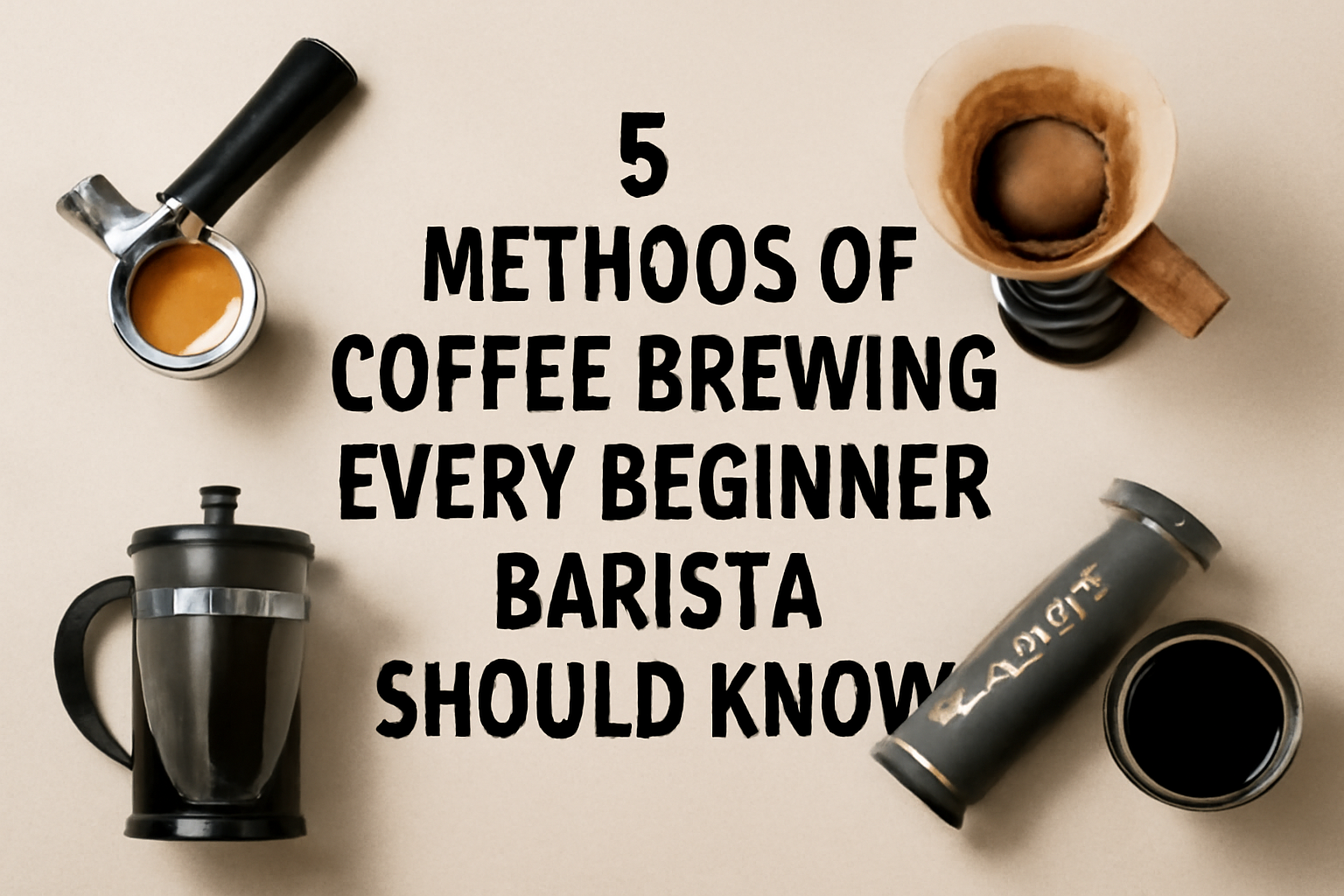As a beginner barista, mastering the art of brewing coffee is the first step toward becoming a true expert in the coffee world. Whether you’re working in a café or simply perfecting your technique at home, understanding the different brewing methods available will help you create a wide range of delicious coffee beverages. Each method brings out unique characteristics in the coffee beans and offers distinct textures, flavors, and aromas.
In this article, we’ll cover five of the most popular coffee brewing methods every beginner barista should know. From espresso to pour-over, French press, Aeropress, and cold brew, we’ll break down the essentials of each brewing method and provide tips for perfecting your technique. So, let’s dive in and explore the exciting world of coffee brewing.
1. Espresso: The Foundation of Coffee Drinks
Espresso is the backbone of many coffee drinks, including lattes, cappuccinos, macchiatos, and Americanos. As a barista, mastering espresso is essential for creating high-quality beverages. It’s a concentrated form of coffee made by forcing hot water under high pressure through finely-ground coffee beans. The result is a small, intense shot of coffee with a rich flavor and a layer of crema (the golden foam that sits on top of the espresso).
Key Elements for a Great Espresso:
- Grind Size: The grind should be very fine, almost like powdered sugar, to ensure proper extraction under pressure.
- Tamping: Tamping the coffee grounds evenly is crucial for creating uniform extraction and avoiding channeling.
- Water Temperature: Ideal water temperature for espresso is between 190°F (88°C) and 200°F (93°C).
- Brewing Time: An espresso shot typically takes around 25-30 seconds to brew, depending on your grind size and the amount of coffee used.
Tips for Espresso Success:
- Invest in a good-quality espresso machine with consistent pressure.
- Always use fresh, high-quality beans, preferably Arabica, for a balanced and rich flavor.
- Practice makes perfect – perfecting your grind size and tamping technique will make a huge difference in the final shot.
2. Pour-Over: A Precision Brewing Method
Pour-over coffee is a manual brewing method that involves pouring hot water over coffee grounds placed in a filter. The water slowly drips through the grounds, extracting the coffee’s flavors in a precise and controlled manner. This method is popular for producing a clean and crisp cup of coffee, highlighting the nuanced flavors and aromatic qualities of high-quality beans.
The most common pour-over equipment includes the Hario V60 and Chemex. These tools allow the barista to have full control over the brewing process, from the water temperature to the pouring technique.
Key Elements for a Great Pour-Over:
- Grind Size: Use a medium to medium-coarse grind, similar to sea salt, to ensure optimal extraction.
- Water Temperature: The water should be between 195°F (90°C) and 205°F (96°C).
- Brewing Time: The entire brew process should take between 2.5 and 3.5 minutes.
- Pouring Technique: Pour the water in slow, circular motions to ensure even saturation of the coffee grounds.
Tips for Pour-Over Success:
- Use a gooseneck kettle for precise pouring control.
- Pre-wet the coffee filter to eliminate paper taste and to help the coffee grounds bloom.
- Experiment with different pouring techniques (e.g., concentric circles or spiral) to achieve the perfect extraction.
3. French Press: Full-Bodied and Rich Coffee
The French press, also known as the press pot or plunger pot, is one of the simplest and most popular brewing methods. It’s ideal for those who enjoy a rich, full-bodied cup of coffee. The French press brewing process involves steeping coarsely ground coffee beans in hot water for several minutes, and then pressing the grounds to separate them from the brewed coffee.
The result is a coffee with more oils and suspended solids, which gives the cup a fuller, richer texture compared to other brewing methods.
Key Elements for a Great French Press:
- Grind Size: Use a coarse grind, similar to breadcrumbs, to prevent over-extraction and bitterness.
- Water Temperature: Ideal water temperature is around 200°F (93°C).
- Brewing Time: The coffee should steep for 4-5 minutes before pressing.
Tips for French Press Success:
- Stir the coffee grounds before pressing to ensure even extraction.
- Use a timer to ensure accurate brewing times.
- Experiment with different coffee-to-water ratios (typically 1:15) to find your preferred strength.
4. Aeropress: Fast and Versatile Brewing
The Aeropress is a versatile and portable coffee brewing device that allows you to make coffee in just a few minutes. The device works by forcing hot water through the coffee grounds using air pressure, which extracts the coffee quickly and efficiently. The Aeropress produces a strong and smooth cup of coffee, similar to espresso but without the complex machinery.
It’s a popular choice for beginner baristas due to its ease of use, affordability, and quick brewing time.
Key Elements for a Great Aeropress:
- Grind Size: A medium-fine grind, similar to table salt, works best for the Aeropress.
- Water Temperature: The water should be between 175°F (80°C) and 200°F (93°C), depending on the type of coffee you’re using.
- Brewing Time: The brew time is typically 2-3 minutes.
Tips for Aeropress Success:
- Try different brewing methods, such as the inverted method (brewing with the plunger on top) for a stronger cup.
- Experiment with different ratios of coffee to water to find the balance that works best for your taste.
- Use freshly ground beans for the best flavor.
5. Cold Brew: Smooth and Low-Acidity Coffee
Cold brew coffee is made by steeping coarsely ground coffee in cold water for an extended period (usually 12-24 hours). Unlike iced coffee, cold brew coffee is brewed cold, resulting in a smoother, less acidic taste. The slow extraction process produces a concentrated coffee that can be diluted with water or milk before serving.
Cold brew coffee is a great option for beginners who want to experiment with different flavors and brew methods, and it’s perfect for hot summer days.
Key Elements for a Great Cold Brew:
- Grind Size: Use a coarse grind, similar to breadcrumbs, to prevent over-extraction and bitterness.
- Brewing Time: Steep the coffee for 12-24 hours, depending on your desired strength.
- Coffee-to-Water Ratio: A typical cold brew ratio is 1:4 or 1:5, but you can adjust it based on your taste preferences.
Tips for Cold Brew Success:
- Use filtered water for the cleanest, best-tasting cold brew.
- After steeping, strain the coffee through a fine mesh filter or cheesecloth to remove the grounds.
- Serve cold brew over ice or mix it with milk or a sweetener for a refreshing, custom drink.
Conclusion: Mastering the Basics of Coffee Brewing
As a beginner barista, it’s important to familiarize yourself with these five brewing methods: espresso, pour-over, French press, Aeropress, and cold brew. Each method offers a unique coffee experience and helps you understand how different factors like grind size, water temperature, and brewing time affect the final cup.
By experimenting with these techniques and practicing regularly, you’ll soon develop your own preferences and be able to serve delicious coffee drinks with confidence. Remember, the key to becoming a great barista is patience and practice—so get brewing and enjoy the wonderful world of coffee!

I’m an economist with 15 years of experience in strategic planning and a lifelong passion for wellness and natural living. As a self-learner, I created Herbalife Balance to share insights on healthy eating, mindful habits, and an active lifestyle. Tennis enthusiast and nature lover, I believe in balance as a path to well-being. Through this blog, I help others live healthier, more conscious lives.

